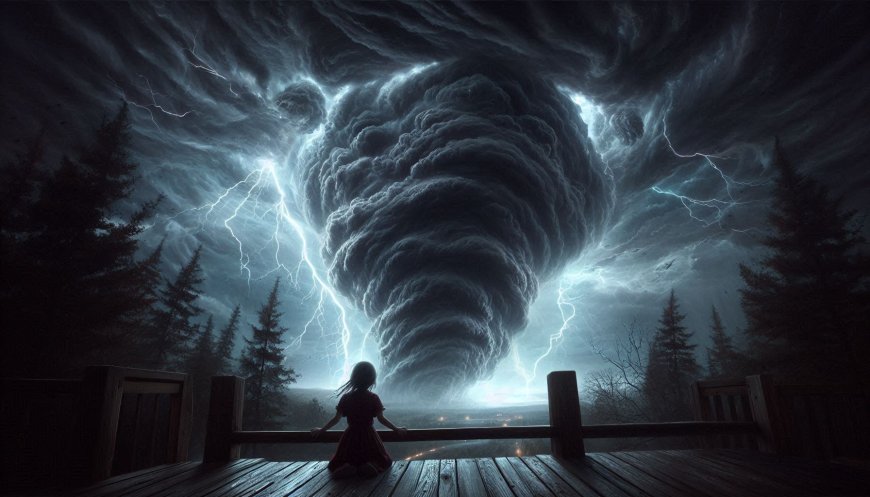The Fire That Outshines the Sun: A Tale of Lightning's Secret Heat
A powerful storm captivates Sarah as she witnesses a lightning bolt hotter than the Sun, illuminating the night with its raw, untamed energy. Explore the extraordinary forces of nature in this breathtaking account of a thunderstorm's might.

The storm rolled in like a living creature, its dark clouds swirling ominously as the wind howled through the trees. Sarah watched from the safety of her porch, eyes wide with both awe and caution. Thunderstorms always fascinated her, their raw power captivating in a way that few other things could. But tonight, something was different. The air felt charged, heavy with electricity, and as she stood there, mesmerized by the flashes of lightning tearing across the sky, she couldn't shake the feeling that she was witnessing something extraordinary.
And then it happened. A single bolt of lightning split the sky, illuminating the world around her with a brilliant, blinding light. It struck so fast, so fiercely, that for a moment, Sarah felt like the world had gone silent, as if time itself had stopped to bow to the sheer force of the strike. Thunder followed a split second later, shaking the ground beneath her feet. She could feel the raw power of it in her bones.
But what Sarah didn't know—what few people ever stopped to consider—was the secret of that lightning bolt. In that brief, fleeting moment, the temperature within the lightning's core had soared to a staggering 30,000 Kelvin, hotter than the very surface of the Sun. It was a mind-boggling fact, one that defied expectation. How could something so brief, so earthly, burn with more intensity than the star that lit their days?
That night, as the storm raged on, Sarah found herself unable to sleep. She was haunted by the lightning's brilliance, by the sheer heat of it, knowing now that each flash was a glimpse into something otherworldly—a force far more powerful than she had ever imagined. The sun, that eternal furnace at the center of their solar system, burned at 5,500 Kelvin on its surface, a steady, constant provider of life. Yet here, in the fleeting seconds of a storm, lightning exceeded it, burning hotter than the Sun itself, a brief but furious release of energy that crackled through the atmosphere.
The thought was both terrifying and exhilarating. Sarah imagined the atoms in the air splitting apart, ionized by the immense heat and energy, creating a plasma hotter than anything she could fathom. The heat was so intense that it could tear apart nitrogen molecules, forcing them to bind with oxygen in a fiery chemical dance, creating nitrogen oxides—compounds that, though dangerous in large amounts, helped fertilize the very earth beneath her feet. In that moment, the lightning wasn’t just a destructive force; it was also part of the cycle of life, feeding the world even as it threatened to destroy.
The storm began to wind down, but Sarah’s mind raced. She thought of the Sun, so far away, so immense. At its core, the Sun burned at 15 million Kelvin, its heat powered by nuclear fusion—the force of countless hydrogen atoms fusing together to form helium, releasing vast amounts of energy in the process. But the Sun's surface, where its light reached Earth, was cooler, like the skin of a star hiding its raging inferno beneath. And yet, even in its cosmic might, the Sun’s outer layer couldn’t match the flash of lightning that had just ripped through the skies over her small town.
The comparison was surreal. Lightning, a natural phenomenon that humans had witnessed since the dawn of time, was hotter than the surface of the Sun. It was as if nature, in its briefest of moments, could outdo the very star that sustained life on Earth.
The more she thought about it, the more she realized how remarkable this juxtaposition was. The Sun—massive, ancient, and constant—had its own slow-burning energy, while the lightning was a sudden, violent burst. It reminded her of the extremes that nature could produce: the steady warmth of the Sun and the sudden, searing fury of a lightning bolt, both equally powerful in their own ways.
Days after the storm, Sarah found herself sharing this discovery with anyone who would listen. “Did you know lightning is hotter than the Sun?” she would ask, watching their eyes widen in disbelief. Most people couldn’t wrap their heads around it at first. How could something so familiar, so terrestrial, surpass the very source of life on Earth in heat? But as Sarah learned more, the idea became a source of endless fascination for her. The temperature of lightning stood as a testament to the incredible forces at work in the universe—forces that shaped the weather, the Earth, and life itself.
The storm had passed, but the story of that bolt of lightning stayed with Sarah. It was a reminder that even in the familiar hum of life, there were secrets waiting to be uncovered, forces far beyond human control or comprehension. The lightning’s heat, so much greater than the Sun’s surface, was a symbol of nature’s untamed power. And every time Sarah saw a storm on the horizon, she would stand outside, watching, waiting, and marveling at the fire in the sky that burned hotter than the star that warmed her days.
What's Your Reaction?






































































































